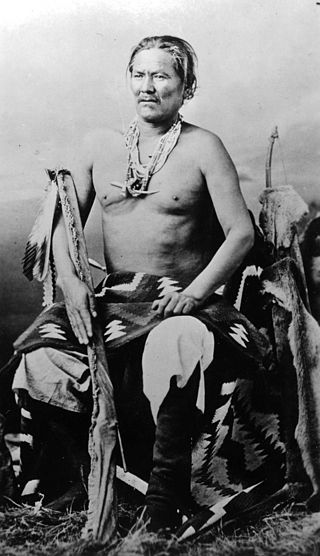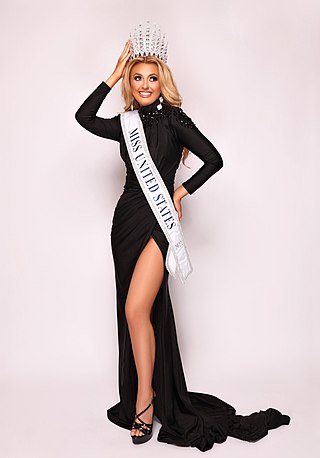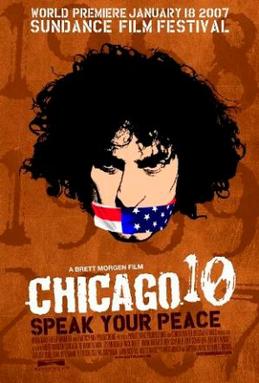
The Navajo are a Native American people of the Southwestern United States.

ITVS is a service in the United States which funds and presents documentaries on public television through distribution by PBS and American Public Television, new media projects on the Internet, and the weekly series Independent Lens on PBS. Aside from Independent Lens, ITVS funded and produced films for more than 40 television hours per year on the PBS series POV, Frontline, American Masters and American Experience. Some ITVS programs are produced along with organizations like Latino Public Broadcasting and KQED.

Miss United States is a pageant held in the United States for unmarried women between the ages of 20 and 29. The pageant includes women selected to represent all 50 states, District of Columbia, American Samoa, Guam, Commonwealth of the Northern Mariana Islands, Puerto Rico, and the U.S. Virgin Islands.

Chicago 10: Speak Your Peace is a 2007 American animated documentary written and directed by Brett Morgen that tells the story of the Chicago Eight. The Chicago Eight were charged by the United States federal government with conspiracy, crossing state lines with intent to incite a riot, and other charges related to anti-Vietnam War and countercultural protests in Chicago, Illinois during the 1968 Democratic National Convention.
Arthur Dong is an American filmmaker and author whose work centers on Asia America and anti-gay prejudice. He was raised in San Francisco, California, graduating from Galileo High School in June 1971. He received his BA in film from San Francisco State University and also holds a Directing Fellow Certificate from the American Film Institute Center for Advanced Film Studies. In 2007, SFSU named Dong its Alumnus of the year “for his continued success in the challenging arena of independent documentary filmmaking and his longstanding commitment to social justice."
Soul! is a performance/variety television program that showcased African American music, dance and literature in the late 1960s and early 1970s. It was produced by New York City public television station WNDT, and distributed by NET and its successor PBS.

Traditional gender roles among Native American and First Nations peoples tend to vary greatly by region and community. As with all Pre-Columbian era societies, historical traditions may or may not reflect contemporary attitudes. Gender roles exhibited by Indigenous communities have been transformed in some aspect by Eurocentric, patriarchal norms and the perpetration of systematic oppression. In many communities, these things are not discussed with outsiders.

The Return of Navajo Boy is a documentary film produced by Jeff Spitz and Bennie Klain about the Cly family, Navajo who live on their reservation. Through them, the film explores several longstanding issues among the Navajo and their relations with the United States government and corporations: environmental racism, media and political representation, off-reservation adoption, and denial of reparations for environmental illnesses due to uranium mining in Monument Valley, Utah, which was unregulated for decades. Bill Kennedy served as the film's executive producer; his late father had produced and directed the earlier silent film The Navajo Boy (1950s), which featured the Cly family.

Two-spirit is a modern, pan-Indian umbrella term used by some Indigenous North Americans to describe Native people in their communities who fulfill a traditional third-gender ceremonial and social role in their cultures. Coined in 1990 as a primarily ceremonial term, requiring community recognition, in recent years more individuals have taken to self-identifying as two-spirit. Two-spirit, as a term and concept, is neither used nor accepted universally in Native American cultures. Indigenous cultures that have traditional roles for gender-nonconforming people have names in their own, Indigenous languages for these people and the roles they fill in their communities.
Miss Navajo is a 2007 independent documentary film directed by Billy Luther. It follows 21-year-old Crystal Frazier who, alongside six other Navajo women, competes in a beauty pageant for the title of Miss Navajo Nation 2005–2006.

The portrayal of Native Americans in television and films concerns indigenous roles in cinema, particularly their depiction in Hollywood productions. Especially in the Western genre, Native American stock characters can reflect contemporary and historical perceptions of Native Americans and the Wild West.

Miss International Queen is the world's biggest beauty pageant for transgender women. The pageant was conceived in 2004 and named the largest and most prestigious by CNN original American documentary television series This Is Life with Lisa Ling aired on 26 November 2017.

Hinaleimoana Kwai Kong Wong-Kalu, also known as Kumu Hina, is a Native Hawaiian māhū – a traditional third gender person who occupies "a place in the middle" between male and female, as well as a modern transgender woman. She is known for her work as a kumu hula, as a filmmaker, artist, activist and as a community leader in the field of Kanaka Maoli language and cultural preservation. She teaches Kanaka Maoli philosophy and traditions that promotes cross-cultural alliances throughout the Pacific Islands. Kumu Hina is known as a "powerful performer with a clear, strong voice"; she has been hailed as "a cultural icon".
The Indian princess is usually a stereotypical and inaccurate representation of a Native American or other Indigenous woman of the Americas. The term "princess" was often mistakenly applied to the daughters of tribal chiefs or other community leaders by early American colonists who mistakenly believed that Indigenous people shared the European system of royalty. This inaccurate portrayal has continued in popular animation, with characters that conform to European standards of beauty, with the most famous misrepresentation being that of Pocahontas. Frequently, the "Indian Princess" stereotype is paired with the "Pocahontas theme" in which the princess "offers herself to a captive Christian knight, a prisoner of her father, and after rescuing him, she is converted to Christianity and lives with him in his native land." - a false narrative that did not even happen quite that way to the real child who inspired the Pocahontas stories. The phrase "Indian princess", when used in this way, is often considered to be a derogatory term, a type of racial slur, and is deemed offensive by Native Americans.
Cristina Ibarra is an American documentary filmmaker who currently lives in Brooklyn, NY. She was a Rauschenberg Fellow, Rockefeller Fellow, a New York Foundation for the Arts Fellow, and a MacArthur Fellow.
Billy Luther is a Native American independent film producer and director. He has made several documentaries and short films. He currently belongs to the Navajo, Hopi, and Laguna Pueblo tribes. He is best known for his documentary Miss Navajo which tells the story of a young Navajo woman competing in the beauty pageant of Miss Navajo.
Beulah Melvin Allen was a Diné physician. In 1952, at the age of 23, she was the first Miss Navajo Nation.
Joseph Hall Wilson is an American film director and producer, best known for documentaries and impact campaigns that explore oppression and empowerment among gender and sexual minority communities. He has received an Emmy, GLAAD Media and several film festival awards, and his work has been supported by the Sundance Institute, Ford Foundation, ITVS and Pacific Islanders in Communications.

A Radiant Curve is a compilation of poems and stories written by professor Luci Tapahonso. It is one of six collective poetry works by Tapahonso. A Radiant Curve is a work with basis in daily life, which is closely related to Luci Tapahonso's Navajo culture. These stories include memories of her family, generational teachings, and her perspective as a Navajo person living in modern times. A Radiant Curve tries to emphasize storytelling in order to speak to the commonality of the shared human experience across cultures as evidenced by the double use of both Navajo and English. The book was published in 2008 by The University of Arizona Press.











